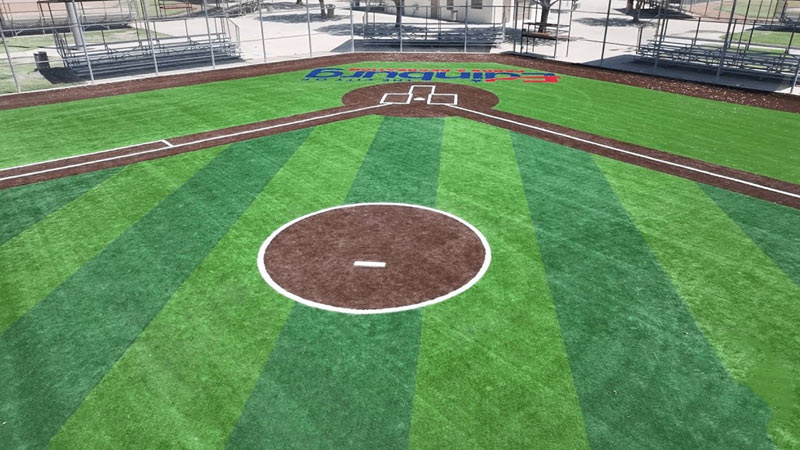Embarking on the journey to turf a baseball field involves meticulous planning and a keen understanding of the associated costs.
From the quality of the turf material to the dimensions of the field and professional installation services, numerous factors influence the overall expense.
In this comprehensive exploration, we delve into how much does it cost to turf a baseball field.
From initial measurements to selecting the right turf type, we’ll guide you through the essential considerations that impact the budget.
Understanding these nuances is key to ensuring a successful and sustainable transformation of your baseball field into a high-performance, all-weather playing surface. So, stay sharp.
The Basics of Turf Baseball Field
Before we learn how much is a turf baseball field, let’s have a clear concept of the turf baseball field.
A turf baseball field, designed for durability and playability, typically features artificial grass made of synthetic materials like polyethylene or nylon.
The turf provides a consistent playing surface, reducing maintenance costs and ensuring games can be played in various weather conditions. The infield often incorporates specialized turf with added padding for player safety.
Unlike natural grass fields, turf requires minimal watering and maintenance, making it an attractive option for all-season play. The turf’s uniform surface contributes to predictable ball bounces and player movements.
Additionally, turf fields are resistant to wear and tear, offering a reliable playing surface for both amateur and professional baseball games.
How Much Turf Is Needed for Baseball Field?
To know how much does a turf baseball field cost, you should first learn how much turf you will need for the field.
To determine the amount of turf needed for a baseball field, several factors must be considered:
Field Dimensions
The size of the baseball field is a crucial factor. Standard dimensions include the outfield’s square footage, the infield’s square footage, and the pitcher’s mound area.
Cutting and Seaming
Turf rolls come in standard sizes, so calculating the number of rolls required involves considering any necessary cutting and seaming to fit the specific dimensions of the field.
Overlap and Waste
Factoring in a percentage for overlap and waste during installation is essential. This accounts for areas that may need extra material due to irregularities in the field’s shape.
Infield and Outfield Differences
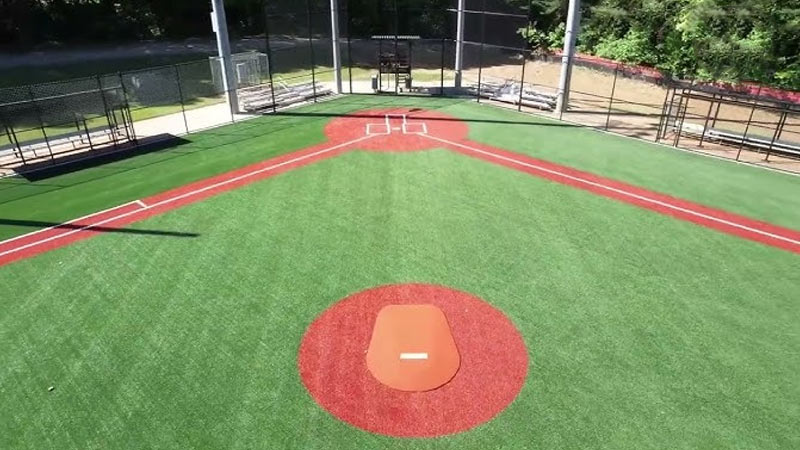
Recognizing that the infield turf may require different specifications than the outfield due to player movements and safety considerations is important for an accurate estimation.
Professional Consultation
Seeking advice from turf experts or suppliers ensures precise calculations, taking into account variations in turf types and any unique features of the baseball field.
How Much Does It Cost to Turf a Baseball Field
There is a reason, why people can’t get exactly how much does it cost to build a turf baseball field. It’s because the price of turf often fluctuates.
Once you know how much to turf a baseball field and the price of the turf, will have an idea. Estimating the cost of turfing a baseball field involves considering various factors that contribute to the overall expenses:
Turf Quality and Type
The cost of turf varies based on the quality and type of synthetic grass chosen. High-performance turfs designed for sports fields may be more expensive but offer enhanced durability.
Field Size
Larger fields require more turf, leading to increased material costs. The dimensions of both the infield and outfield impact the overall budget.
Site Preparation
Expenses associated with site preparation, including clearing existing vegetation, leveling the ground, and addressing drainage issues, contribute significantly to the total cost.
Installation Costs
Professional installation services, including labor, equipment, and adhesive materials, are crucial considerations. Skilled labor ensures proper fitting, reducing the risk of future maintenance issues.
Additional Features
Costs may vary depending on additional features such as shock pads or padding beneath the turf for player safety, specialized infill materials, and any customizations requested by the client.
It’s advisable to consult with turf suppliers and installation professionals to obtain accurate quotes tailored to the specific requirements of the baseball field project.
How Much Does A Turf Infield Cost
Determining the cost of installing a turf infield involves considering various factors that contribute to the overall expenses:
Turf Material Quality
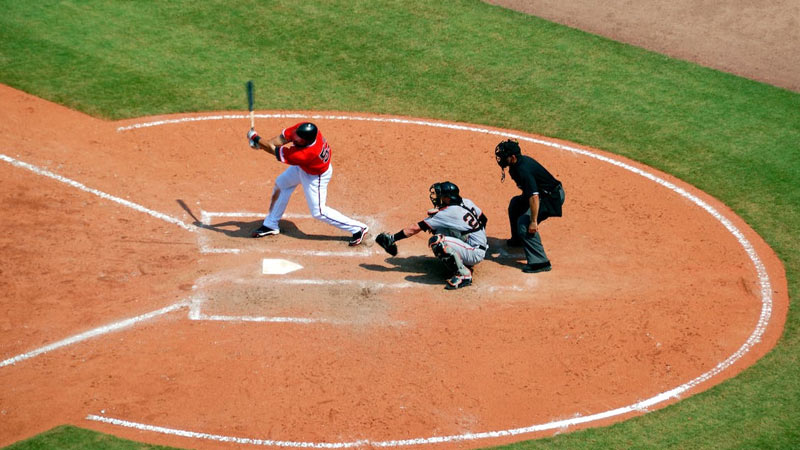
The cost of the turf material itself depends on its quality, durability, and performance characteristics.
High-grade turf designed for sports fields often comes at a higher price but offers better playability and longevity.
Field Size and Dimensions
The size of the infield directly influences the amount of turf needed and, subsequently, the cost. Larger infields will require more material and labor for installation.
Site Preparation
Clearing the existing infield, leveling the ground, and addressing any drainage issues are essential steps in the installation process. Site preparation costs contribute significantly to the overall expenses.
Installation Services
Hiring professionals for the installation involves costs for labor, equipment, and additional materials like adhesives and infill. Skilled installation ensures a proper fit and enhances the longevity of the turf.
Maintenance Considerations
While not an immediate cost, factoring in long-term maintenance expenses is important. Quality turf may require minimal maintenance, contributing to cost savings over time.
To get an accurate estimate for a turf infield project, it’s recommended to consult with turf suppliers and installation professionals who can provide customized quotes based on specific dimensions and requirements.
Calculating the Cost of Turf Baseball Field
Calculating the cost of turfing a baseball field involves considering several key factors. Here’s a step-by-step guide:
Field Dimensions
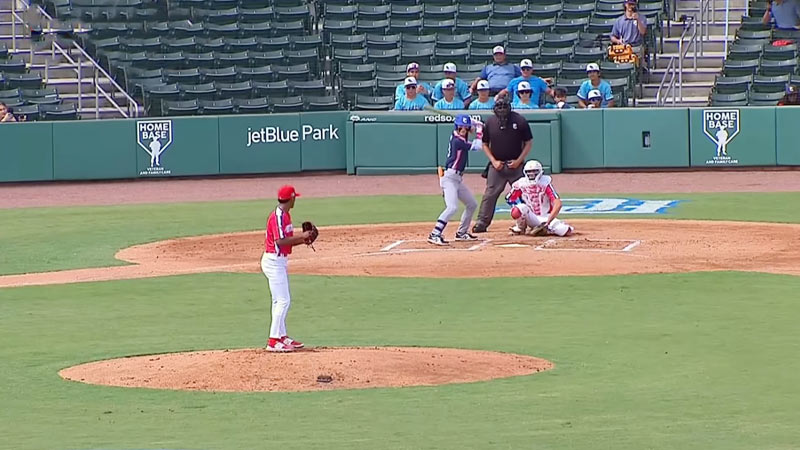
Measure the dimensions of the baseball field, including the outfield, infield, and pitcher’s mound. Calculate the total square footage to determine the amount of turf required.
Turf Material Cost
Research and obtain quotes from turf suppliers based on the selected turf type and quality. Multiply the cost per square foot by the total square footage needed for the field.
Site Preparation
Estimate the cost of site preparation, including clearing existing vegetation, leveling the ground, and addressing drainage issues.
Site preparation costs are often calculated separately from the turf material costs.
Installation Costs
Factor in the cost of professional installation services, including labor, equipment, adhesives, and any additional materials required for proper installation.
Installation costs may vary based on the complexity of the project.
Contingency and Additional Features
Include a contingency fund for unexpected expenses. If there are additional features like padding, shock pads, or customizations, add these costs to the total.
Quotes and Professional Consultation
Obtain detailed quotes from turf suppliers and installation professionals.
Consulting with experts ensures a more accurate estimation, taking into account specific project requirements and potential challenges.
By carefully considering these factors and obtaining detailed quotes, you can arrive at a more precise calculation for the cost of turfing a baseball field.
How Much Does It Cost to Turf a High School Baseball Field?
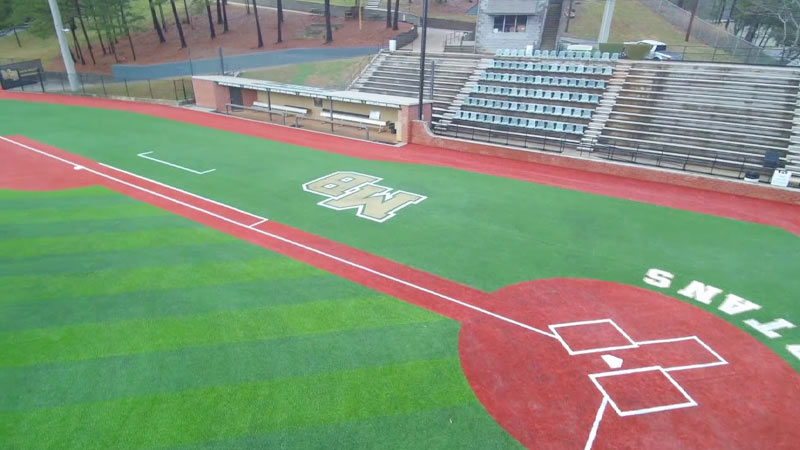
Turfing a high school baseball field involves several factors that contribute to the overall cost. Here’s a breakdown:
Field Size and Dimensions
High school baseball fields vary in size, so accurately measuring and assessing the dimensions is crucial. Larger fields will require more turf material, impacting the overall cost.
Quality of Turf Material
The choice of turf material significantly influences the cost.
High-quality, durable turf designed for sports fields may have a higher upfront cost but can provide long-term benefits in terms of performance and reduced maintenance.
Site Preparation
Clearing the existing field, leveling the ground, and addressing drainage issues are essential steps. Site preparation costs, including excavation and ground leveling, should be factored into the budget.
Installation Services
Professional installation services, including labor, equipment, adhesives, and infill materials, contribute to the overall cost. Skilled installation ensures proper fitting and optimal performance of the turf.
Additional Features and Customizations
Consider any additional features, such as shock pads, padding for player safety, or customizations to meet specific requirements.
These can add to the overall cost but may enhance the field’s quality and playability.
To obtain an accurate cost estimate for turfing a high school baseball field, it’s advisable to consult with turf suppliers and experienced installation professionals who can provide detailed quotes based on the specific needs of the field.
FAQs
How is the cost of turfing a baseball field calculated?
The cost is determined by factors like field dimensions, turf material quality, site preparation, and installation services.
Measure the field, obtain turf quotes, consider site preparation and installation costs, and factor in any additional features for an accurate estimation.
Does the type of turf impact the overall cost?
Yes, the quality and type of turf significantly influence costs.
Higher-grade turf designed for sports fields may have a higher upfront cost, but it often provides better playability and durability, leading to long-term savings in maintenance.
Are there hidden costs associated with turf installation?
Hidden costs may include site preparation expenses, additional features like padding, and potential contingencies.
Consulting with turf experts helps identify and account for all potential costs to ensure a comprehensive budget.
Can you provide a ballpark figure for turfing a standard-sized baseball field?
Costs vary based on factors like location, field size, and chosen turf quality.
Generally, estimates range from $5 to $15 per square foot, encompassing material, installation, and site preparation costs. However, obtaining detailed quotes is crucial for accuracy.
Are there long-term savings associated with turfing a baseball field?
Yes, despite the initial investment, turf fields often result in long-term savings due to reduced maintenance costs associated with watering, mowing, and field repairs.
High-quality turf also minimizes downtime, providing a more consistent and durable playing surface.
Wrapping Up
The costs of turfing a baseball field, it’s evident that this investment is more than just a financial decision—it’s a commitment to long-term playability, reduced maintenance, and enhanced durability.
By carefully considering the unique aspects of your field and seeking professional advice, you can embark on this transformative journey with confidence.
It will create a lasting impact on the quality and resilience of your baseball facility. Thank you for supporting us.

